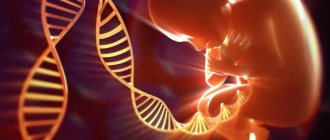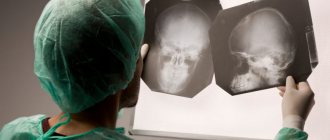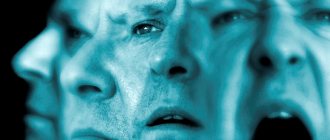Schizophrenia is a mental illness that is associated with impaired mental and emotional functioning.
Such a state leads to the destruction of a person’s mental sphere, to his disorganization and, ultimately, to the complete disintegration of the personality. The disease is replete with a variety of symptoms, which are divided into 2 large groups: positive and negative symptoms. As with any mental disorder, the signs of schizophrenia are often ambiguous, so it can sometimes be difficult to identify. Moreover, this disease requires careful and timely diagnosis, as this is the key to successful treatment.
Schizophrenia and its causes
The first mention of schizophrenia, or schizophrenia as it was called, dates back to the 17th century BC. But, naturally, a clear, clear definition of the disease was not given then.
This concept was introduced into psychiatry in 1908 by the Swiss psychiatrist Eugen Bleuler. He clearly limited this concept from other mental disorders and defined it as a separate disease.
Literally, from Greek, the disease is translated as “split of the mind.” But this concept should not be compared with a split personality. It is also impossible to draw parallels between this term and dementia. The basis of schizophrenia is a violation of the coordinated functioning of the psyche, a breakdown of connections between its components: perception, thinking, attention, emotions. As a result of this, it cannot work as a single mechanism, causing all kinds of failures.
The reasons for the development of such a disorder have not been precisely and definitively established. To date, there are only theories of the occurrence of such a condition:
- Heredity.
- Risk factors during pregnancy. People born during the winter and spring months are thought to be more likely to develop the disease. Prenatal infections and gene mutations also play a role.
- Social status. It has been established that the development of schizophrenia is influenced by such criteria as low material level, racial persecution, lack of work, family problems, isolation from society, and loneliness.
- Childhood traumatization. Manifestations of the disease in adulthood are provoked by traumatic factors suffered by a person in childhood: sexual and physical violence, loss of parents, lack of proper upbringing and care.
- Psychological conditions. Increased emotionality, decreased resistance to stress.
- Excess dopamine. Excessive release of the neurotransmitter dopamine in the brain leads to constant stimulation of the “reward system”, which causes most of the symptoms. However, this hypothesis is increasingly fading into the background.
- Addiction.
- Changes in some brain structures. For example, enlargement of the ventricles and decrease in gray matter.
Symptoms
The most “favorite” age for schizophrenia is from 16 to 30 years. The disease affects both men and women. As a rule, it is preceded by warning symptoms in the form of irritability, social withdrawal and frequent mood swings. Detection of the prodromal period is possible two and a half years before the onset of progression of the disorder.
The main diagnostic criteria for schizophrenia are manifestations of productive and negative symptoms.
Productive symptoms are signs that indicate excessive work of the psyche, the so-called “reflection without an object.” These include:
- hallucinations – mainly auditory. They appear due to damage to the temporal lobe and are a characteristic and early symptom of schizophrenia. They appear as voices in the patient’s head, and he feels it (pseudo-hallucinations). These voices appear in different guises: they can talk to each other, comment on something, or give orders. For example, one patient said that when entering a store, he heard voices in his head that persistently recommended that he hit the salesman on the head;
- delusion is a persistent pathological belief in something, in which it is difficult to convince a person of the opposite. For example, frequent delusional ideas in schizophrenia are delusions of persecution (by special services) and confidence that the individual is performing an over-the-top mission;
- depersonalization – the patient seems to look at himself from the outside, without really perceiving his body and the world around him.
In addition, people suffering from schizophrenia have a strong belief that someone is stealing their thoughts, or that other people are hearing them, or, conversely, that they are being implanted in the patient’s head. Chaotic speech, incoherent thinking and behavioral reactions are also common.
Publications in the media
Schizophrenia is a mental illness of a continuous or paroxysmal course, begins mainly at a young age, is accompanied by characteristic personality changes (autization, emotional-volitional disorders, inappropriate behavior), thought disorders and various psychotic manifestations. Frequency - 0.5% of the population. 50% of beds in psychiatric hospitals are occupied by patients with schizophrenia.
Genetic aspects . A priori, polygenic inheritance seems most likely. Non-scientific application of a broader definition of schizophrenia leads to an increase in population frequency estimates to 3%. The existence of several loci that contribute to the development of schizophrenia has been proven or suggested ( • SCZD1, 181510, 5q11.2‑q13.3; • amyloid b A4 precursor protein, AAA, CVAP, AD1, 104760, 21q21.3‑q22.05; • DRD3 , 126451, 3q13.3; SCZD3, 600511, 6p23; SCZD4, 600850, 22q11‑q13; EMX2, 600035, 10q26.1.
CLINICAL PICTURE
Clinical manifestations of schizophrenia are polymorphic. Various combinations of symptoms and syndromes are observed.
Negative symptoms . In psychiatry, the term “negative” means the absence of certain manifestations inherent in a healthy person, i.e. loss or distortion of mental functions (for example, impoverishment of emotional reactions). Negative symptoms are decisive in diagnosis.
• Thinking disorders. Patients with schizophrenia rarely have only one type of impaired thinking; usually a combination of different types of thought disorder is noted • • Diversity. Minor features of everyday things seem more significant than the object as a whole or the general situation. Manifested by ambiguity, vagueness, and thoroughness of speech • • Discontinuity. There is no semantic connection between concepts while the grammatical structure of speech is preserved. Speech loses its communication properties, ceases to be a means of communication between people, retaining only its external form. Characterized by a gradual or sudden deviation in the thought process towards random associations, a tendency towards symbolic thinking, characterized by the coexistence of the direct and figurative meaning of concepts. There are sudden and incomprehensible transitions from one topic to another, a comparison of the incomparable. In extreme cases, speech is devoid of semantic meaning and is inaccessible to understanding if it is constructed outwardly correctly. In severe cases of disrupted thinking, the patient spews out a sequence of completely unrelated words, and pronounces them as one sentence (verbal okroshka) • • Sperrung (blockage of thinking) - an unexpected break in the train of thought or a long delay in the thought process, loss of the thread of conversation. The disorder occurs with clear consciousness, which is different from absence seizure. The patient begins his thought or answer and suddenly stops, often in the middle of a sentence. • • Reasoning - thinking with a predominance of florid, unsubstantial, empty and fruitless reasoning, devoid of cognitive meaning • • Neologisms - new words invented by the patient, often by combining syllables taken from different words; the meaning of neologisms is understandable only to the patient himself (for example, the neologism “tabushka” is created from the words “stool” and “cabinet”). To the listener they sound like absolute nonsense, but to the speaker these neologisms are a kind of reaction to the inability to find the right words.
• Emotional disorders •• Emotional disorders in schizophrenia are manifested primarily by the extinction of emotional reactions, emotional coldness. Due to decreased emotionality, patients lose their sense of affection and compassion for loved ones. Patients become unable to express any emotions. This makes it difficult to communicate with patients, causing them to withdraw even more into themselves. Patients in the later stages of schizophrenia do not have strong emotions; if they appear, one should doubt whether the diagnosis of schizophrenia was correctly made. Emotional coldness manifests itself first and to the greatest extent in feelings towards parents (usually the patient responds to the care of parents with irritation; the warmer the attitude of the parents, the more obvious the patient’s hostility towards them). As the disease progresses, such dulling or atrophy of emotions becomes more and more noticeable: patients become indifferent and indifferent to their surroundings . great caution. People with schizophrenia exhibit both positive and negative emotions, although not as strongly as healthy people. Some people with schizophrenia, who appear to have no emotions, actually live a rich emotional inner life and have a hard time experiencing their inability to express emotions • • Ambivalence. The coexistence of two opposing tendencies (thoughts, emotions, actions) towards the same object in the same person at the same time. It manifests itself as the inability to complete certain actions or make a decision.
• Volitional disorders. Emotional disorders are often associated with decreased activity, apathy, lethargy and lack of energy. A similar picture is often observed in patients who have suffered from schizophrenia for many years. Severe volitional disorders lead to an unconscious withdrawal from the outside world, a preference for the world of one’s own thoughts and fantasies, divorced from reality (autism). Patients with severe volitional disorders look inactive, passive, and lacking initiative. As a rule, emotional and volitional disorders are combined with each other; they are designated by the same term “emotional-volitional disorders.” Each patient has an individual relationship between emotional and volitional disorders in the clinical picture. The severity of emotional-volitional disorders correlates with the progression of the disease.
• Personality changes result from the progression of negative symptoms. They manifest themselves in pretentiousness, mannerism, absurdity of behavior and actions, emotional coldness, paradox, and unsociability.
Positive ( psychotic ) manifestations . The term “positive” (“productive”) in psychiatry means the appearance of states that are not characteristic of a healthy psyche (for example, hallucinations, delusions). Positive symptoms are not specific to schizophrenia, because also occur in other psychotic conditions (for example, organic psychoses, temporal lobe epilepsy). The predominance of positive symptoms in the clinical picture indicates an exacerbation of the disease.
• Hallucinatory-paranoid syndrome is manifested by a combination of poorly systematized, inconsistent delusional ideas, often persecution, with a syndrome of mental automatism and/or verbal hallucinations • • For the patient, apparent images are as real as objectively existing ones. Patients actually see, hear, smell, and do not imagine. For patients, their subjective sensory sensations are as valid as those emanating from the objective world • • The behavior of a patient experiencing hallucinations seems crazy only from the point of view of an outside observer; to the patient himself it seems quite logical and clear • • Delusions and hallucinations are considered one of the most important and common symptoms of schizophrenia, but one symptom is not enough to diagnose this disease. Many patients with schizophrenia with a whole range of other symptoms, such as thought disorders, emotional and volitional disorders, have never observed delusions or hallucinations. It must also be remembered that delusions and hallucinations are inherent not only in schizophrenia, but also in other mental illnesses, so their presence does not necessarily indicate that the patient has schizophrenia.
• Mental automatism syndrome (Kandinsky–Clerambault syndrome) is the most typical type of hallucinatory-paranoid syndrome for schizophrenia. The essence of the syndrome is the feeling of the violent origin of disorders, their “madeness” • • Alienation or loss of belonging to one’s “I” of one’s own mental processes (thoughts, emotions, physiological functions of the body, movements and actions performed), the experience of their involuntary, madeness, imposition from the outside. Characteristic symptoms of openness, withdrawal of thoughts and mentism (an involuntary influx of thoughts) • • Pseudo-hallucinations (sensations and images that arise involuntarily without a real stimulus, differing from hallucinations in the patient’s lack of a sense of the objective reality of these images) • • Mental automatism syndrome usually accompanies systematized delusions of persecution and impact. Patients no longer belong to themselves - they are at the mercy of their persecutors, they are puppets, toys in their hands (sense of mastery), they are under the constant influence of organizations, agents, research institutes, etc.
• Paraphrenic syndrome is a combination of expansive delusions with delusions of persecution, auditory hallucinations and (or) mental automatisms. In this state, along with complaints about persecution and influence, the patient expresses ideas about his world power, cosmic power, calls himself the god of all gods, the ruler of the Earth; promises the creation of heaven on earth, the transformation of the laws of nature, radical climate change. Delusional statements are characterized by absurdity, grotesqueness, statements are given without evidence. The patient is always at the center of unusual and sometimes grandiose events. Various manifestations of mental automatism and verbal hallucinosis are observed. Affective disorders manifest themselves in the form of elevated mood, which can reach the level of mania. Paraphrenic syndrome, as a rule, indicates the age of onset of schizophrenia.
• Capgras syndrome (a delusional belief that people around them are capable of changing their appearance for a specific purpose).
• Affective-paranoid syndrome •• Depressive-paranoid syndrome is manifested by a combination of depressive syndrome, delusions of persecution, self-blame, verbal hallucinations of an accusing nature • • Manic-paranoid syndrome is manifested by a combination of manic syndrome, delusions of grandeur, noble origin, verbal hallucinations of an approving, praising nature .
• Catatonic syndrome •• Catatonic stupor. Characterized by increased muscle tone, catalepsy (freezing for a long time in a certain position), negativism (unreasonable refusal, resistance, opposition to any outside influence), mutism (lack of speech with a intact speech apparatus). Cold, uncomfortable posture, wet bed, thirst, hunger, danger (for example, a fire in a hospital) are not reflected in any way on their frozen, amicable face. Patients remain in the same position for a long time; all their muscles are tense. A transition from catatonic stupor to excitement and vice versa is possible • • Catatonic excitement. Characterized by an acute onset, suddenness, chaoticity, lack of focus, impulsiveness of movements and actions, senseless pretentiousness and mannerisms of movements, absurd unmotivated exaltation, aggression.
• Hebephrenic syndrome. Characterized by silly, ridiculous behavior, mannerisms, grimacing, lisping speech, paradoxical emotions, impulsive actions. May be accompanied by hallucinatory-paranoid and catatonic syndromes.
• Depersonalization-derealization syndrome is characterized by a painful experience of changes in one’s own personality and the surrounding world that cannot be described.
Depression in schizophrenia
Depressive symptoms in schizophrenia (both during exacerbation and in remission) are often observed. Depression is one of the most common causes of suicidal behavior in patients with schizophrenia. It should be remembered that 50% of patients with schizophrenia make suicide attempts (15% are fatal). In most cases, depression is due to three reasons.
• Depressive symptoms may be an integral part of the schizophrenic process (for example, when depressive-paranoid syndrome predominates in the clinical picture).
• Depression can be caused by awareness of the severity of their illness and the social problems that patients face (narrowing of their social circle, misunderstanding on the part of loved ones, being labeled as “crazy,” work maladjustment, etc.). In this case, depression is a normal personality reaction to a serious illness.
• Depression often occurs as a side effect of antipsychotic medications.
CLASSIFICATION
The division of schizophrenia according to its clinical forms is carried out according to the predominance of a particular syndrome in the clinical picture. This division is conditional, because only a small number of patients can be confidently classified as one type or another. Patients with schizophrenia are characterized by significant changes in the clinical picture during the course of the disease, for example, at the beginning of the disease the patient is noted to have a catatonic form, and after a few years he also experiences symptoms of the hebephrenic form.
Forms of schizophrenia
• The simple form is characterized by a predominance of negative symptoms without psychotic episodes. A simple form of schizophrenia begins with the loss of previous motivations for life and interests, idle and meaningless behavior, and isolation from real events. It progresses slowly, and the negative manifestations of the disease gradually deepen: decreased activity, emotional flatness, poor speech and other means of communication (facial expressions, eye contact, gestures). Efficiency in study and work decreases until they stop completely. Hallucinations and delusions are absent or occupy a small place in the picture of the disease.
• Paranoid form is the most common form; The clinical picture is dominated by hallucinatory-paranoid syndrome and mental automatism syndrome. The paranoid form is characterized by the predominance in the picture of the disease of delusional and hallucinatory disorders, forming paranoid, paranoid syndromes, Kandinsky-Clerambault syndrome of mental automatism and paraphrenic syndrome. At first, they note a tendency towards systematization of nonsense, but later it becomes more and more fragmentary, absurd and fantastic. As the disease progresses, negative symptoms appear and intensify, creating a picture of an emotional-volitional defect.
• The hebephrenic form is characterized by the predominance of hebephrenic syndrome. This form differs from the simple one in the patients’ greater mobility, fussiness with a touch of foolishness and mannerisms, and instability of mood is characteristic. Patients are verbose, prone to reasoning, stereotypical statements, their thinking is poor and monotonous. Hallucinatory and delusional experiences are fragmentary and striking in their absurdity. According to E. Kraepelin, only 8% of patients experience favorable remissions, but in general the course of the disease is characterized by malignancy.
• The catatonic form is characterized by the predominance of the catatonic syndrome in the clinical picture of the disease. This form manifests itself as a catatonic stupor or agitation. These two states can alternate with each other. Catatonic disorders are usually combined with hallucinatory-delusional syndrome, and in the case of an acute paroxysmal course of the disease - with oneiric syndrome.
Flow and types of flow
There are continuous and paroxysmal-progressive types of schizophrenia. Before the advent of ICD-10, there were two more types of progression in Russian psychiatry: recurrent and sluggish. In ICD-10 (as well as in DSM-IV), there are no diagnoses of recurrent schizophrenia and sluggish schizophrenia. Currently, these disorders are identified as separate nosological units - schizoaffective disorder and schizotypal disorder, respectively (see Schizoaffective disorder, Schizotypal disorder).
• The continuous type of course is characterized by the absence of clear remissions during treatment and the steady progression of negative symptoms. Spontaneous (without treatment) remissions are not observed with this type of course. Subsequently, the severity of productive symptoms decreases, while negative symptoms become more and more pronounced, and in the absence of treatment effect, it comes to the complete disappearance of positive symptoms and pronounced negative symptoms. A continuous type of course is observed in all forms of schizophrenia, but it is exceptional for simple and hebephrenic forms.
• The paroxysmal-progressive type of course is characterized by complete remissions between attacks of the disease against the background of progression of negative symptoms. This type of schizophrenia in adulthood is the most common (according to various authors, it is observed in 54–72% of patients). Attacks vary in severity, clinical manifestations and duration. The appearance of delusions and hallucinations is preceded by a period of severe affective disorders - depressive or manic, often replacing each other. Mood fluctuations are reflected in the content of hallucinations and delusions. With each subsequent attack, the intervals between attacks become shorter and the negative symptoms worsen. During the period of incomplete remission, patients retain anxiety, suspicion, a tendency to delusionally interpret any actions of others, and hallucinations occasionally occur. Particularly characteristic are persistent subdepressive states with decreased activity and a hypochondriacal orientation of experiences.
Research methods . There is no effective test to diagnose schizophrenia. All studies are aimed mainly at excluding an organic factor that could cause the disorder • Laboratory research methods: •• CBC and OAM •• biochemical blood test •• study of thyroid function •• blood test for vitamin B12 and folic acid •• analysis blood for the content of heavy metals, drugs, psychoactive drugs, alcohol • Special methods •• CT and MRI: exclude intracranial hypertension, brain tumors •• EEG: exclude temporal lobe epilepsy • Psychological methods (personality questionnaires, tests [for example, Rorschach tests, MMPI ]).
Differential diagnosis
• Psychotic disorders caused by somatic and neurological diseases. Symptoms similar to those of schizophrenia are observed in many neurological and somatic diseases. Mental disorders in these diseases usually appear at the onset of the disease and precede the development of other symptoms. Patients with neurological disorders tend to be more critical of their illness and more concerned about the onset of symptoms of mental illness than those with schizophrenia. When evaluating a patient with psychotic symptoms, an organic etiological factor is always excluded, especially if the patient exhibits unusual or rare symptoms. The possibility of superimposed organic disease should always be kept in mind, especially when a patient with schizophrenia has been in remission for a long time or when the quality of symptoms changes.
• Simulation. Schizophrenic symptoms can be invented by the patient or for the purpose of obtaining “secondary benefit” (simulation). Schizophrenia can be simulated, because The diagnosis is largely based on the patient's statements. Patients who actually suffer from schizophrenia sometimes make false complaints about their supposed symptoms in order to receive some benefits (for example, a transfer from disability group 3 to disability group 2).
• Mood disorder. Psychotic symptoms are observed in both manic and depressive states. If a mood disorder is accompanied by hallucinations and delusions, their development occurs after pathological changes in mood occur, and they are not stable.
• Schizoaffective disorder. In some patients, symptoms of mood disorders and symptoms of schizophrenia develop simultaneously and are expressed equally; Therefore, it is extremely difficult to determine which disorder is primary - schizophrenia or a mood disorder. In these cases, a diagnosis of schizoaffective disorder is made.
• Chronic delusional disorder. The diagnosis of delusional disorder is valid for systematized delusions of non-bizarre content, lasting at least 6 months, with the preservation of normal, relatively high personality functioning without pronounced hallucinations, mood disorders and the absence of negative symptoms. The disorder occurs in adulthood and old age.
• Personality disorders. Personality disorders can be combined with manifestations characteristic of schizophrenia. Personality disorders are stable characteristics that determine behavior; the time of their appearance is more difficult to determine than the moment of onset of schizophrenia. As a rule, there are no psychotic symptoms, and if they are present, they are transient and unexpressed.
• Reactive psychosis (brief psychotic disorder). Symptoms last less than 1 month and occur after a clearly defined stressful situation.
TREATMENT
Social and psychological support in combination with drug therapy can reduce the frequency of exacerbations by 25–30% compared to the results of treatment with antipsychotics alone. Psychotherapy for schizophrenia is ineffective, so this treatment method is rarely used.
The nature of the disease is explained to the patient, they are reassured, and their problems are discussed with him. They try to form an adequate attitude towards the disease and treatment in the patient, and the skills to timely recognize signs of an impending relapse. An excessive emotional reaction of the patient’s relatives to his illness leads to frequent stressful situations in the family and provokes exacerbations of the disease. Therefore, the patient’s relatives must be explained the nature of the disease, treatment methods and side effects (the side effects of antipsychotics often frighten relatives).
Basic principles of drug therapy
• Drugs, doses, and duration of treatment are selected individually, strictly according to indications, depending on the symptoms, severity of the disorder and stage of the disease.
• Preference should be given to a drug that has previously been effective in a given patient.
• Treatment usually begins with small doses of drugs, gradually increasing them until the optimal effect is obtained. In case of acute development of an attack with severe psychomotor agitation, the drug is administered parenterally; if necessary, injections are repeated until the excitement is completely relieved, and subsequently the treatment method is determined by the dynamics of the psychopathological syndrome.
• The most common mistake is prescribing more antipsychotics to patients than necessary. Studies have shown that smaller amounts of antipsychotics usually produce the same effect. When a clinic increases a patient’s dose of antipsychotic medications every day, creating the impression that this is intensifying treatment and reducing psychotic symptoms, in fact, this effect depends only on the duration of exposure to the drug. Long-term administration of antipsychotics in large doses often leads to the development of side effects.
• Subjective severe sensations after the first dose of the drug (usually associated with side effects) increase the risk of a negative treatment outcome and patient evasion from treatment. In such cases, you need to think about changing the drug.
• The duration of treatment is 4–6 weeks, then, if there is no effect, the treatment regimen is changed.
• When incomplete and unstable remission occurs, the dose of drugs is reduced to a level that ensures the maintenance of remission, but does not cause depression of mental activity and pronounced side effects. This maintenance therapy is prescribed for a long time on an outpatient basis.
Basic drugs
Neuroleptics - chlorpromazine, levomepromazine, clozapine, haloperidol, trifluoperazine, flupentixol, pipothiazine, zuclopenthixol, sulpiride, quetiapine, risperidone, olanzapine.
Antidepressants and tranquilizers are prescribed for depression and anxiety, respectively. When the depressive effect is combined with anxiety and motor restlessness, antidepressants with a sedative effect, such as amitriptyline, are used. For depression with lethargy and decreased behavioral energy, antidepressants with a stimulating effect, such as imipramine, or without a sedative effect, such as fluoxetine, paroxetine, citalopram, are used. Tranquilizers (eg, diazepam, bromodihydrochlorophenylbenzodiazepine) are used short-term to treat anxiety.
Complications during treatment with neuroleptics
Long-term therapy with antipsychotics can lead to the development of persistent complications. Therefore, it is important to avoid unnecessary treatment by varying doses depending on the patient's condition. Anticholinergic drugs prescribed to relieve adverse extrapyramidal symptoms, with long-term continuous use, increase the risk of tardive dyskinesia. Therefore, anticholinergic drugs not used constantly and for prophylactic purposes , but are prescribed only in case of adverse extrapyramidal symptoms.
• Akineto-hypertensive syndrome •• Clinical picture: mask-like face, rare blinking, stiffness of movements •• Treatment: trihexyphenidyl, biperiden.
• Hyperkinetic-hypertensive syndrome •• Clinical picture: akathisia (restlessness, feeling of restlessness in the legs), tasykinesia (restlessness, desire to constantly move, change position), hyperkinesis (choreiform, athetoid, oral) •• Treatment: trihexyphenidyl, biperiden.
• Dyskinetic syndrome •• Clinical picture: oral dyskinesia (tension of the masticatory, swallowing, tongue muscles, an irresistible desire to stick out the tongue), oculogyric crises (painful rolling of the eyes) •• Treatment: trihexyphenidyl (6–12 mg/day), 20% caffeine solution 2 ml s.c., chlorpromazine 25–50 mg i.m.
• Chronic dyskinetic syndrome •• Clinical picture: hypokinesia, increased muscle tone, hypomimia in combination with local hyperkinesis (complex oral automatisms, tics), decreased motivation and activity, acairia (intrusiveness), emotional instability •• Treatment: nootropics (piracetam 1200– 2400 mg/day for 2–3 months), multivitamins, tranquilizers.
• Malignant neuroleptic syndrome •• Clinical picture: dry skin, acrocyanosis, sebaceous hyperemic face, forced posture - on the back, oliguria, increased blood clotting time, increased residual nitrogen in the blood, renal failure, decreased blood pressure, increased body temperature •• Treatment: infusion therapy (reopolyglucin, hemodez, crystalloids), parenteral nutrition (proteins, carbohydrates).
• Intoxication delirium develops more often in men over 40 years of age (with a combination of chlorpromazine, haloperidol, amitriptyline. Treatment is detoxification.
Prognosis for 20 years: recovery - 25%, improvement - 30%, care and/or hospitalization required - 20% • 50% of patients with schizophrenia attempt suicide (15% with a fatal outcome) • The older the age of onset, the more favorable the prognosis • The more pronounced the affective component of the disorder, the more acute and shorter the attack, the better it responds to treatment, and the greater the chance of achieving complete and sustainable remission.
Synonyms . Bleuler's disease, Dementia praecox, Discordant psychosis, Dementia praecox
ICD-10 • F20 Schizophrenia
Notes.
• pfropfschizophrenia (from German Pfropfung - vaccination) - schizophrenia developing in an oligophrenic "oligoschizophrenia" pfropfhebephrenia "vaccinated schizophrenia
• Huber's senesthetic schizophrenia - schizophrenia with a predominance of senestopathies in the form of burning sensations, constriction, tearing, turning over, etc.
• schizophrenia-like psychosis (pseudoschizophrenia) is a psychosis similar or identical in clinical picture to schizophrenia.
• schizophrenia-like syndrome is the general name for psychopathological syndromes similar in manifestations to schizophrenia, but occurring in other psychoses.
• nuclear schizophrenia (galloping) - rapid development of emotional devastation with the disintegration of pre-existing positive symptoms (end state).
Negative symptoms in schizophrenia
Negative symptoms in the development of schizophrenia are called complete or partial loss of normal mental reactions. It includes a wide range of manifestations:
- smoothness of affect. Affect is the internal perception and outward manifestation of emotions. In schizophrenia, this process is very scarce, characterized by a poverty of emotions or their absence in principle. Such a person is not able to understand the feelings of others. This disorder is manifested by depression, mood lability, guilt, and fear. This leads to social maladaptation and isolation, since it is very difficult to establish contact with the patient. He begins to avoid people because he finds himself misunderstood;
- alogia – paucity of speech. She becomes poor and uninformative. If such patients are asked a question, the answer is usually short and concise. A woman suffering from the disease said that it was so difficult for her to speak that she was physically unable to explain her condition to her loved ones;
- Anhedonia is the inability to derive pleasure and enjoyment from activities that previously evoked positive emotions. Lack of motivation and activity to achieve it;
- sleep disturbance – problems falling asleep, insomnia, interrupted sleep;
- physical sensations – headaches and dizziness, malaise. Vestibular disorders are manifested by an unsteady gait, the person becomes clumsy. A characteristic symptom is stupor, as well as muscle hyper- or hypotonicity, small twitches.
Cognitive impairments are observed, which are sometimes also classified as negative symptoms. These are thinking disorders that manifest themselves as decreased attention and memory, lack of logic and the ability to reason.
The perception of sounds is distorted, the surrounding world seems blurry. The patient's anxiety worsens and he becomes withdrawn.
Causes of the disease:
According to modern clinical research, schizophrenia is genetic, that is, it is inherited. However, other theories are also being considered to explain its occurrence:
Neurotransmitter theory
She studies how medications used for treatment, which are collectively called “antipsychotics,” affect patients. This theory includes 3 basic hypotheses:
- Dopamine According to it, the main trigger for the appearance of the disorder is an increased level of the hormone dopamine in the patient. Traditionally, the hormone dopamine has a stimulating effect on the nervous system of a healthy person, but its excess can lead to hyperstimulation of brain activity, which leads to improper functioning of neurons.
- Serotoninova In this case, the cause of the disease is disturbances in the transmission of serotonin through neurons. Receptors begin to work excessively, which ultimately leads to the depletion of certain brain functions.
- Noradrenergic Suggests that the manifestation of schizophrenic symptoms is primarily influenced by the process of decay of neurons that make up the noradrenergic system.
Dysontogenetic theory
Also called the “brain development disorder” theory . Thanks to research, it was found that schizphorenics have constitutional changes in the structure of the brain. It is worth noting that these anomalies are not extensive, so the pathological changes do not progress.
However, in the presence of a stressful or other traumatic factor, the patient may experience decompensation of these structural abnormalities, provoking the development of a mental disorder.
The theory also suggests that the cause of deviations may be complex internal infections, a toxic environment or genetic destruction.
Psychoanalytic theory
It is logical to note that the founder of this approach is Sigmund Freud. He assumed that the disease occurs in people who are closely dependent on the ego, and the origins of such attempts come from childhood. Traumatic situations in childhood and adolescence (cold attitude of parents towards their child) can also be the cause of narcissism and egocentrism, and the symptoms of schizophrenic disorder, including destruction of thinking and delusions of persecution, are their direct consequences.
Genetic theory (constitutional and genetic predisposition)
Some time ago it was believed that schizophrenia, as a disease, has only genetic prerequisites, that is, it is transmitted exclusively by inheritance. There is a significant grain of truth in this conclusion, since the presence of a similar diagnosis in close relatives significantly increases the chances of its development in descendants. Now it is believed that it is not the disease itself that is inherited, but only a predisposition to a number of mental illnesses (alcoholism, epilepsy, suicide, and, in particular), but it can manifest itself or not, depending on the environmental factors in which a person grows.
Theory of internal intoxication (autointoxication and autoimmunization)
It implies that the cause of the development of the disease may be a violation of protein metabolism in the body, and, accordingly, internal poisoning with toxic products that appear as a result of a violation of this metabolism. For example, ammonia, phenol and cresols. Accumulating in the body, they inhibit the correct course of basic processes, which leads to metabolic disorders, the impossibility of timely restoration of the nervous system, and, accordingly, to neurodynamic disorders in schizophrenia.
Cognitive theory
Refers to a cluster of biological hypotheses that consider a biological factor as the fundamental cause that is the trigger in the development of the disease. It is this theory that pays special attention to the study of hallucinogenic symptoms in a patient, which lead to a distorted perception of existing reality.
Infectious theory of genesis of schizophrenia
It assumes the development of the disease as a result of a combination of chronic and acute (usually conditionally pathogenic) infection and, accordingly, inhibition of protective immunobiological mechanisms.
In simpler terms, the reasons can be described as:
- heredity;
- perinatal period (disorders of fetal development in utero);
- destructive social environment (urbanization, low standard of living);
- psychotrauma received in early childhood;
- unfavorable environment;
- brain injury (considered perinatal or early natal periods);
- chemical dependencies (alcoholism, drug addiction);
- any severe stress, anxiety and shock.
Obligate symptom of schizophrenia
One of the obligatory negative symptoms of schizophrenic disorder is abulia - lack of willpower. Characterized by a loss of desire and motivation for any kind of activity that previously aroused interest. Such people are passive and lack initiative.
As the disease progresses, abulia develops into apato-abulia syndrome, an extreme degree of volitional disorder. A typical picture: a person is constantly alone, sitting or lying down, he can watch TV all day, but does not grasp the meaning of what he is watching. He refuses to take a shower, perform morning daily procedures, get a haircut, sleeps without changing clothes, and defecates anywhere.
At the same time, it is possible to intensify some unconscious instincts: sexual or food. The latter is manifested by uncontrolled absorption of food.
Such patients do not make verbal contact; their speech is poor. They explain their refusal to engage in dialogue by saying that they are tired.
Another distortion of the volitional sphere is parabulia. It is manifested by unfinished activities, impulsiveness and pretentious actions.
The patient is characterized by ambivalence - duality of reasoning and action. For example, he declares himself fat and thin, devil and god.
Another symptom is negativism. The patient performs contradictory actions. If someone hands him an apple, he refuses. But as soon as the fruit is removed, the person asks for it again.
All these negative symptoms can be primary, arising as a consequence of a pathological process, or secondary. They appear under the influence of external factors and often become negative attitudes towards the patient from others, close people and long-term hospital treatment.
A special role is played by the use of certain medications, in particular antipsychotics. But when they are canceled, the negative symptoms also disappear. This is an indicator by which you can determine whether the symptoms are progression of the disease or a side effect of treatment.
Types of schizophrenia
Depending on the manifestation of symptoms, the following forms of the disease are distinguished:
- Paranoid form. In paranoid schizophrenia, productive symptoms prevail over negative symptoms. The main signs of this form are hallucinations and delusions.
- Catatonic form. Movement disorders are observed - catatonic stupor and agitation. Stupor is characterized by hypertonicity and lack of movement; the person freezes in a bizarre position. At the same time, consciousness is relatively normal. There are no delusions or hallucinations; he perceives information, but is unable to speak or control his body. Catatonia gives way to excitement.
- Hebephrenic form. Its peculiarity is intellectual disorders and impoverishment in the emotional sphere. Such patients are characterized by incoherent and illogical statements, foolish behavior, and productive symptoms.
- Circular shape. Productive symptoms, alternation between depressive and excited states.
But there are other types of disease that are characterized by an atypical course. One of these forms is low-grade schizophrenia.
Sluggish schizophrenia
This type of disease is also called low-progressive schizophrenia or schizotypal disorder and is characterized by a slight progression of the process.
In a less progressive form of the disease, the symptoms are slightly different.
Neurotic disorders predominate, and productive symptoms are often represented by obsessive-phobic, depersonalization, and hysterical disorders.
The disease begins to manifest itself with some minor oddities in behavior. Sometimes loved ones do not focus on this, not even suspecting that they are symptoms of a serious illness:
- apathy and feelings of alienation;
- preference for loneliness and solitude, rejection of strangers;
- the desire to stand out from the crowd. For this purpose, unique clothing and style are used, inappropriate behavior in the form of loud laughter and speech, antics;
- increased negativism towards others, criticality and suspicion, groundless claims. Such people see enemies everywhere;
- groundless anger and desire for revenge;
- do not accept criticism towards themselves, clear confidence in their rightness;
- pretentious speech and demonstrative behavior.
This is how a girl named Ellis Evans, who acquired the disease at the age of 20, describes the beginning of her pathological history. She walked through the city, and it seemed to her completely deserted and abandoned. The buildings were destroyed and all the people disappeared.
Signs in men and women
In men, symptoms appear earlier. At first he becomes cold and aloof, and begins to be hostile towards others, including those who love him. He often lashes out at his loved ones and is rude to everyone for no reason.
All this happens against a background of apathy and inactivity. He suddenly loses interest in his favorite hobby, work or study. Even things that used to bring great pleasure become uninteresting. The patient's appearance also changes. He stops shaving, washes less often, and wears wrinkled and dirty clothes. Sometimes he breaks off all contacts and withdraws into himself, preferring the inner world to the outer one.
In women, low-grade schizophrenia usually appears at the age of 20-30 years. The signs are about the same as in men - fears, obsessions and rituals. Moreover, the latter can be very unusual. For example, a patient does not dare to enter the door until she has counted to 15. There are cases that patients do not sit on a chair until they have walked around it several times. The problem is that the woman is not aware of the absurdity of such actions.
Stages and types of disease
Sluggish schizophrenia has 3 stages of development.
The disease begins with a latent stage, which is characterized by vague symptoms. Personality disorders and disturbances in the emotional sphere are observed. Characterized by depression and mild manic disorders. Hysterical and anxious reactions often develop, and paranoid episodes are possible.
In adolescence, indicative symptoms are skipping exams, refusing to go out and communicate with other people.
The next stage is active, in which the symptoms “bloom.” It is characterized by alternating attacks of the disease with periods of sluggish progress of the process. During this period, schizophrenia can occur in several ways:
- Obsessive-phobic reactions, when the patient is visited by obsessions and fears. Characterized by panic attacks, various rituals and protective actions.
- Depersonalization is a decrease in vital activity, detachment and alienation, loss of mental flexibility, and the ability to quickly switch attention. Emotional scarcity appears, the inability to receive pleasure. Patients themselves note that they grow dull, become primitive and callous.
- Hypochondriacal reactions manifest themselves either in fears for their health, or in the appearance of pretentious, pathological sensations.
- Hysterical reactions - mannered behavior. Such individuals are demonstrative, cutesy and flirtatious. Complex and vivid hysterical symptom complexes with impaired consciousness, stupor or agitation, panic fears, visions, and convulsive seizures are possible. Patients are distinguished by deceit and adventurism, many of them eventually become vagabonds, eccentric and attracting attention with their bright appearance.
Sluggish schizophrenia is also characterized by a simple form, which is characterized by negative symptoms. People of this type are characterized by a decrease in energy potential, scarcity of emotions, and depression. Common symptoms are:
- asthenia;
- low mood;
- social isolation;
- inability to experience positive emotions;
- strange and unpleasant sensations in the body and internal organs;
- passive behavior;
- slowness and inhibition of reactions;
- decreased cognitive function.
The third stage is the stabilization of all processes. Pathological symptoms fade away, and the patient returns to normal behavior.
Slightly progressive schizophrenia is capable of “hiding” and not attracting the attention of others for a long time. And only a specialist can identify its signs.
Signs in children and adolescents
Sluggish schizophrenia can develop in children, even at 7 years of age. The first signs are groundless fears and conversations with invisible interlocutors. Subsequently, the following symptoms appear:
- Paranoia. The child believes that everyone, including his family, wants to hurt him.
- Fears. Even an ordinary situation or object can cause panic fear. And over time there are more and more of them.
- Insulation. The baby loses interest in friends, books, cartoons and toys.
- Moodiness. The mood of children with low-progressive schizophrenia changes very often, and it is almost impossible to please them.
- Speech disorders. The child does not formulate thoughts well and cannot logically justify certain judgments. Sometimes they just say phrases that are not related to the topic of conversation.
The impetus for the development of sluggish schizophrenia in childhood can be the period of puberty, the onset of which occurs at 11-12 years. The teenager becomes very emotional, he develops a tendency towards depression and suicidal tendencies. It is possible that he will develop schizophrenia.
The following signs should be observed:
- Changes in speech. The patient says inappropriate phrases, gets confused, gets confused and cannot logically construct a thought.
- Deterioration in academic performance. Pathology begins to interfere with normal learning. It is difficult for a teenager to concentrate and solve a problem. He takes on one task, then another, without completing them.
- Communication problems. The teenager does not make contact, refuses to make friends, and does not make eye contact during a conversation.
Some of these signs can also be observed in healthy people. But when there are a lot of symptoms, it becomes dangerous to ignore them. You should at least consult a psychologist.
A child may find a new and strange hobby and often gets angry when he is prevented from doing something, even if it is absolutely absurd.
The behavior of a child with indolent schizophrenia should seem strange to parents. If you see that he is beginning to be interested in religious teachings and is trying to strictly follow some rules, and this is not accepted in your family, talk to a specialist. Don’t try to explain everything away with the workload at school and the impact of the Internet on your child.
Diagnosis of schizophrenia
The diagnosis of any type of disease is made on the basis of an examination of the patient by a clinical psychologist, social worker and, of course, a psychiatrist. The main role here is played by the anamnesis, collected from the words of the patient and his immediate environment.
A differential diagnosis is made with other mental disorders.
For example, it is possible to draw a parallel between low-grade schizophrenia and neuroses. With neurosis-like conditions, the appearance of phobias and obsessive thoughts is not uncommon, as with schizophrenia. But these fears do not have an absurd connotation, they are quite understandable and can even be stopped by the person himself through defensive reactions.
Schizophrenia can also be compared to personality disorders. But in this state, oddities in behavior can be traced from childhood and accompany the person constantly. Schizophrenia-like conditions are characterized by development from a certain point when, as before, the patient lived a normal life.
There are two systems used to diagnose schizophrenia: DSM-5 and ICD-10.
In ICD-10, this concept is encrypted under the code F20.0-F20.3. To be assigned this disease to a patient, he must have one of the following symptoms:
- the feeling that a person’s thoughts are heard by everyone around him;
- delusional ideas characterized by inadequacy and absurdity;
- auditory hallucinations that seem to emanate from the head;
- delusional sensations, actions.
Or at least two of the following:
- any hallucinations accompanied by delusions;
- fragmented thinking, creation of new words (parvel - steam locomotive and bicycle);
- catatonia;
- negative signs leading to social isolation;
- changes in behavior leading to a narrowing of the circle of interests, withdrawal into oneself, and detachment from others.
These manifestations should accompany the person for at least a month.
Help with diagnostics
Pay attention to several characteristic signs that accompany the disease at the beginning of its onset. Perhaps they will help to recognize the disease in time:
- Social withdrawal. The person loses contact with loved ones. He tries to avoid meeting people, which is why he does not go to school or work. He becomes indifferent to previously loved things and hobbies.
- Personal hygiene. Problems with hygiene begin with the patient performing all procedures very slowly, gradually this interval increases even more. And over time, he generally stops brushing his teeth, washing himself, etc.
- Obsession with the supernatural. A person becomes overly interested in mysticism, extrasensory perception, and most often religion. Religious hallucinations are possible. Most likely, this is due to a break with reality.
- Sudden sharpness and activity in movements and facial expressions.
- Auditory hallucinations.
These symptoms are almost always present at the beginning of the development of schizophrenia and are important indicators of its occurrence.
Prevention
To prevent the progression of the disease, the patient must engage in prevention. First of all, you should eliminate bad habits and streamline your life. In general, doctors advise adhering to the following rules:
- Follow a daily routine - get up early, get enough sleep, eat on time, walk in the fresh air every day.
- Do physical exercises - do exercises, ride a bike or ski, go to the pool.
- Eliminate stress - you should avoid conflicts and stressful situations, limit communication with people who provoke arguments.
- Eat right - give up alcohol, coffee, strong tea, spicy and fatty foods, and include foods with vitamins and minerals in your diet.
- Visit doctors - regularly come to talk with a psychotherapist or psychologist, especially during periods of loss of strength and bad mood.
Schizophrenia is not a death sentence. With this diagnosis, you can lead a comfortable life at a high quality level. But for this you will have to work on yourself, your behavior and daily routine. If you do everything according to the doctor’s instructions, the likelihood of relapses is reduced. However, no specialist can give a 100% prognosis, since schizophrenia, including sluggish, is a very unpredictable pathology.
Treatment of schizophrenia
The question of whether it is possible to recover from schizophrenia is quite controversial. But, definitely, with proper therapy it is possible to achieve stable and long-term remission. The prognosis is especially favorable for the sluggish form.
Proper treatment involves a comprehensive approach. Schizophrenic patients are allowed to undergo outpatient treatment, but if the process worsens, hospitalization is required. It can also be forced if a person resists.
First of all, drug therapy is required, which must be carried out exactly as prescribed by the doctor. It includes drugs that are classified as antipsychotics and act on both productive and negative signs of the disease.
Antipsychotics block dopamine receptors, thereby reducing the activity of this mediator. Classical antipsychotic drugs affect dopamine receptors, but bypass muscarinic and adrenal receptors. Typical representatives of this group are Chlorpromazine, Haloperidol, Thioridazine.
It has been established that these drugs can only block positive signs. They do not affect negative reactions and, on the contrary, can lead to their occurrence.
Atypical antipsychotics are more adapted to the treatment of the disease. They affect all types of receptors and eliminate both negative and positive symptoms. These drugs include Olanzapine, Clozapine, Risperidone.
Clozapine is recommended for use in treatment-resistant forms of schizophrenia, when the disease does not respond to treatment with most medications. It is highly effective; in addition, it helps to give up bad habits and reduces the risk of suicide.
Despite the obvious advantages, the use of atypical antipsychotics has its own side effects. Thus, the use of Olanzapine in the treatment of schizophrenia leads to the development of diabetes mellitus and metabolic disorders, and Risperidone causes pathological weight gain.
When treating with antipsychotics, it is important not to deviate from the prescribed treatment regimen and not to adjust the dose yourself. Otherwise, this threatens with a number of dire consequences.
In addition to pharmacotherapy, psychotherapy is necessary in the treatment of schizophrenic illness, namely:
- cognitive-behavioural;
- psychoanalysis;
- family therapy;
- art therapy.











